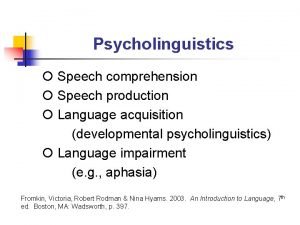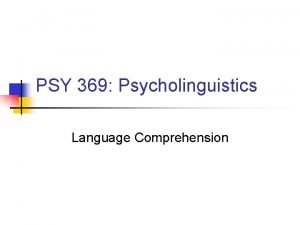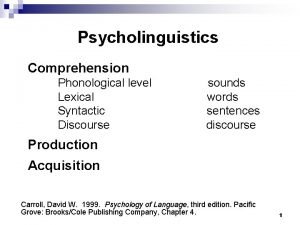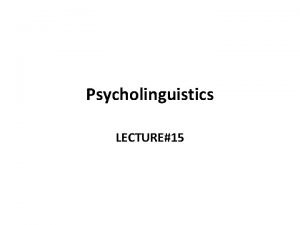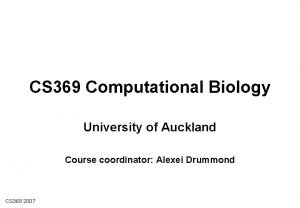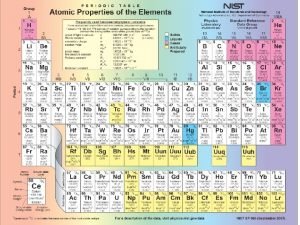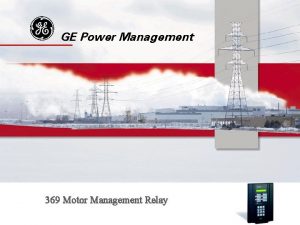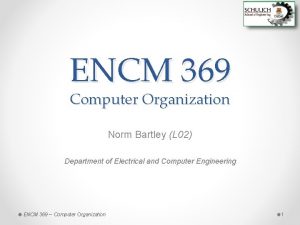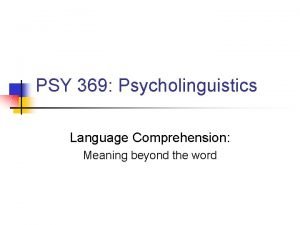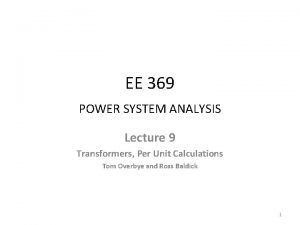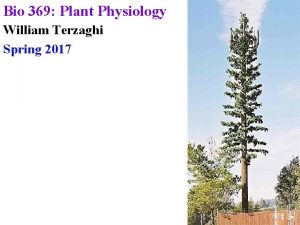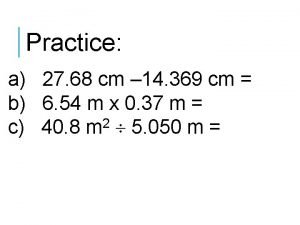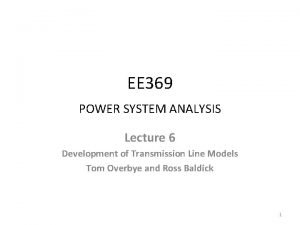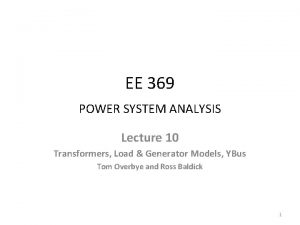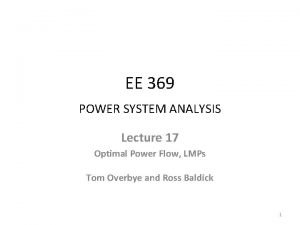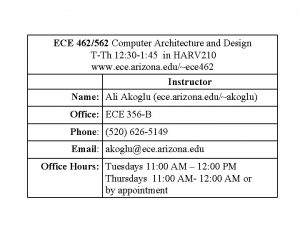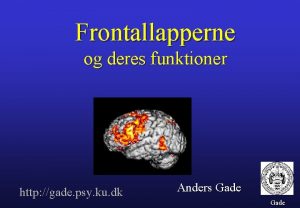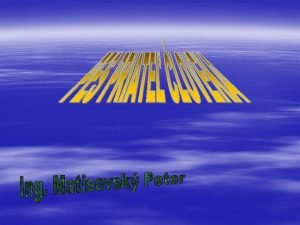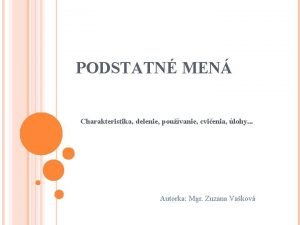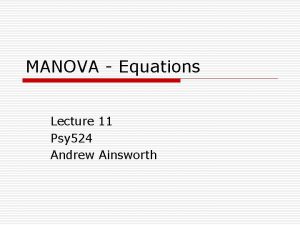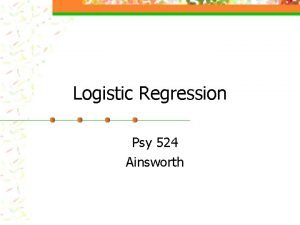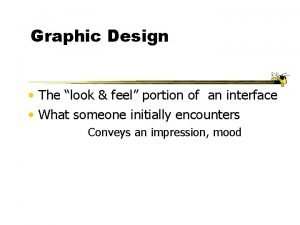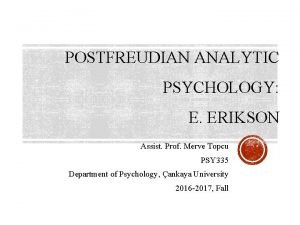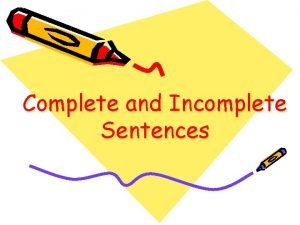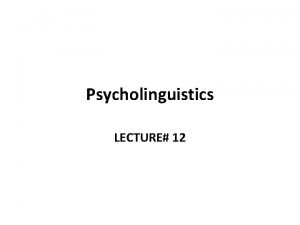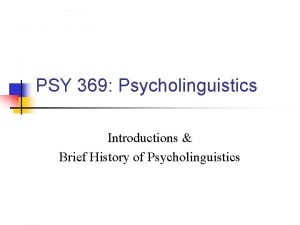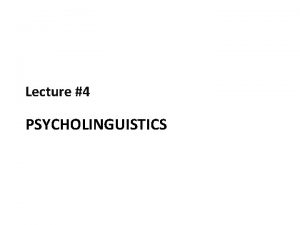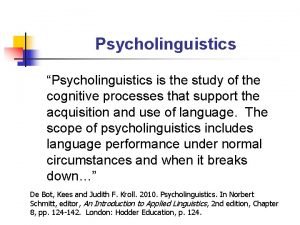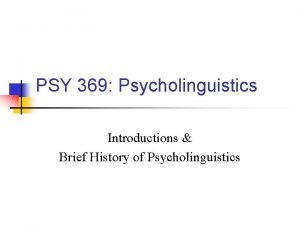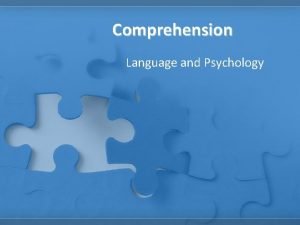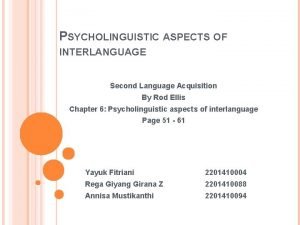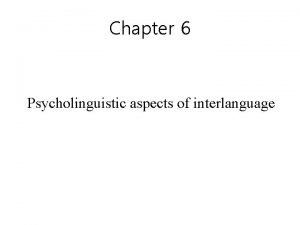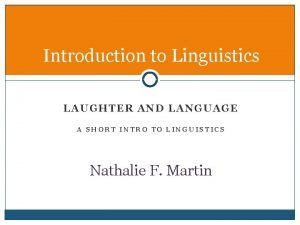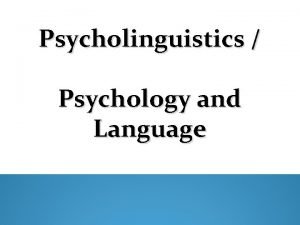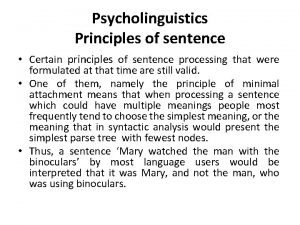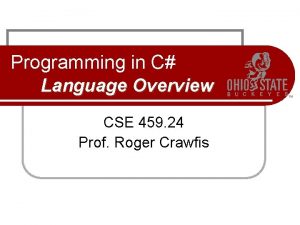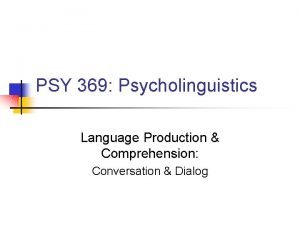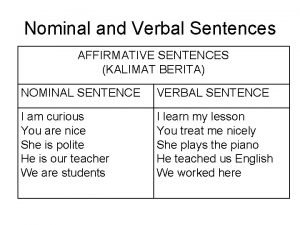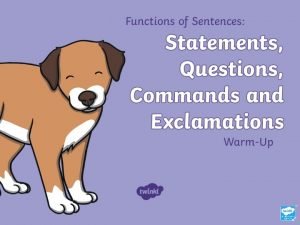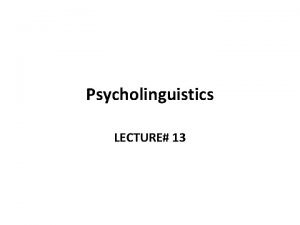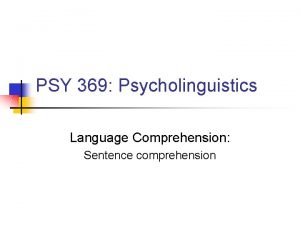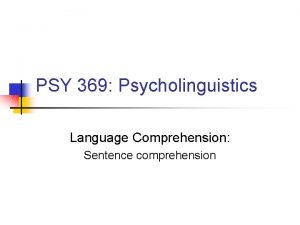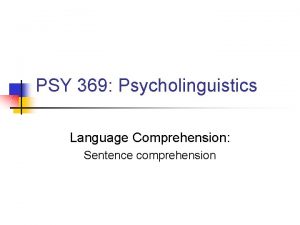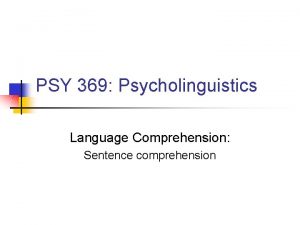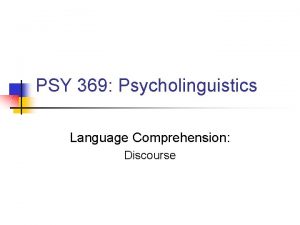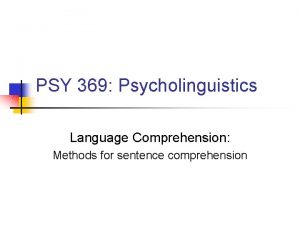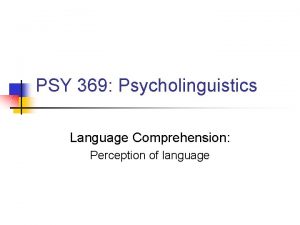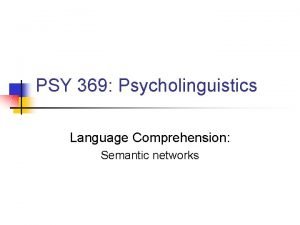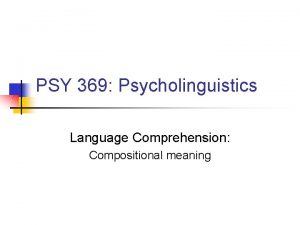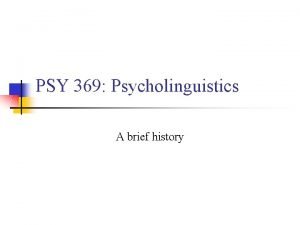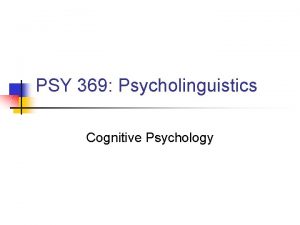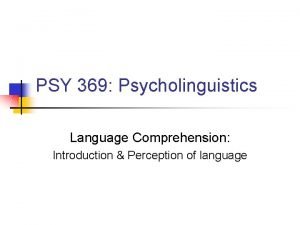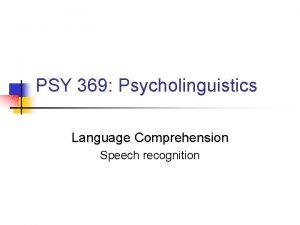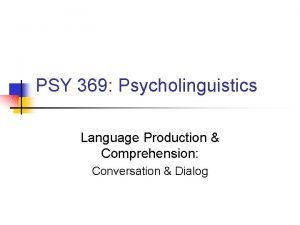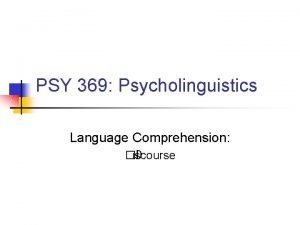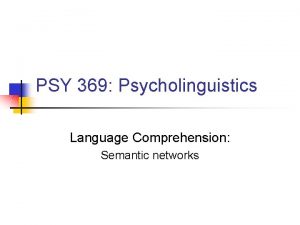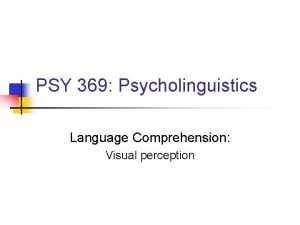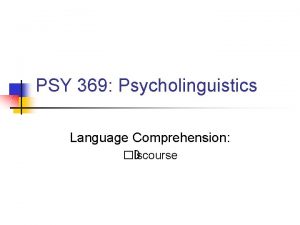PSY 369 Psycholinguistics Language Comprehension Sentence comprehension Overview



























































- Slides: 59

PSY 369: Psycholinguistics Language Comprehension: Sentence comprehension

Overview of comprehension Input The cat chased the rat. Language perception c a t /k/ /ae/ /t/ Word recognition cat dog cap wolf tree yarn cat claw fur hat Syntactic Semantic & pragmatic analysis S NP VP the cat V NP chased the rat

Eye-movements in reading n One of the most common measures used in sentence comprehension research is measuring Eye-movements Clothes make the man. Naked people have little or no influence on society.

Eye-movements in reading n One of the most common measures used in sentence comprehension research is measuring Eye-movements Clothes make the man. Naked people have little or no influence on society.

The Human Eye n n At its center is the fovea, a pit that is most sensitive to light and is responsible for our sharp central vision. The central retina is conedominated and the peripheral retina is roddominated.

Retinal Sampling

Retinal Sampling

Eye-movements in reading n Limitations of the visual field n 130 degrees vertically, 180 degrees horizontally (including peripheral vision n Perceptual span for reading: 7 -12 spaces Clothes make the man. Naked people have little or no influence on society.

Measuring Eye Movements Purkinje Eye Tracker n n n Laser is aimed at the eye. Laser light is reflected by cornea and lens Pattern of reflected light is received by an array of lightsensitive elements. Very precise Also measures pupil accomodation No head movements

Measuring Eye Movements Video-Based Systems n n Infrared camera directed at eye Image processing hardware determines pupil position and size (and possibly corneal reflection) Good spatial precision (0. 5 degrees) for head-mounted systems Good temporal resolution (up to 500 Hz) possible

Eye Movements n Within the visual field, eye movements serve two major functions n n Saccades to Fixations – Position target objects of interest on the fovea Tracking – Keep fixated objects on the fovea despite movements of the object or head

Fixations n n The eye is (almost) still – perceptions are gathered during fixations The most important of eye “movements” n n 90% of the time the eye is fixated duration: 150 ms - 600 ms

Saccades n Saccades are used to move the fovea to the next object/region of interest. n n Connect fixations Duration 10 ms - 120 ms n n Very fast (up to 700 degrees/second) No visual perception during saccades n n Vision is suppressed Evidence that some cognitive processing may also be suppressed during eye-movements (Irwin, 1998) Video examples: 1|2|3|4

Saccades Move to here

Saccade w/o suppression

Saccades Move to here

Saccades

Saccades n Saccades are used to move the fovea to the next object/region of interest. n n Connect fixations Duration 10 ms - 120 ms n n No visual perception during saccades n n n Very fast (up to 700 degrees/second) Vision is suppressed Ballistic movements (pre-programmed) About 150, 000 saccades per day

Smooth Pursuit n n Smooth movement of the eyes for visually tracking a moving object Cannot be performed in static scenes (fixation/saccade behavior instead)

Smooth Pursuit versus Saccades n n n n Jerky No correction Up to 700 degrees/sec Background is not blurred (saccadic suppression) n Smooth pursuit n n Smooth and continuous Constantly corrected by visual feedback Up to 100 degrees/sec Background is blurred

Eye-movements in reading n Eye-movements in reading are saccadic rather than smooth Clothes make the man. Naked people have little or no influence on society. Video examples: 1|2|3|4

The man hit the dog with the leash. S NP det N The man

The man hit the dog with the leash. S NP VP V det N The man hit

The man hit the dog with the leash. S NP VP V NP NP det N The man hit the dog

The man hit the dog with the leash. S NP VP V NP NP det N The man hit the dog PP Modifier with the leash

The man hit the dog with the leash. S NP VP V NP NP det N The man hit the dog PP Instrument with the leash

The man hit the dog with the leash. n How do we know which structure to build?

Parsing n The syntactic analyser or “parser” n n Main task: To construct a syntactic structure from the words of the sentence as they arrive Main research question: how does the parser “make decisions” about what structure to build?

Different approaches n Immediacy Principle: access the meaning/syntax of the word and fit it into the syntactic structure n n Serial Analysis (Modular): Build just one based on syntactic information and continue to try to add to it as long as this is still possible Interactive Analysis: Use multiple levels (both syntax and semantics) of information to build the “best” structure

Sentence Comprehension n n Modular Interactive models

Different approaches n Immediacy Principle: access the meaning/syntax of the word and fit it into the syntactic structure n n Serial Analysis (Modular): Build just one based on syntactic information and continue to try to add to it as long as this is still possible Interactive Analysis: Use multiple levels (both syntax and semantics) of information to build the “best” structure Parallel Analysis: Build both alternative structures at the same time Minimal Commitment: Stop building - and wait until later material clarifies which analysis is the correct one.

Sentence Comprehension n A vast amount of research focuses on: Garden path sentences n A garden path sentence invites the listener to consider one possible parse, and then at the end forces him to abandon this parse in favor of another.

Real Headlines Juvenile Court to Try Shooting Defendant Red tape holds up new bridge Miners Refuse to Work after Death Retired priest may marry Springsteen Local High School Dropouts Cut in Half Panda Mating Fails; Veterinarian Takes Over Kids Make Nutritious Snacks Squad Helps Dog Bite Victim Hospitals are Sued by 7 Foot Doctors

Sentence Comprehension n Garden path sentences n The horse raced past the barn fell. S NP The horse VP

Sentence Comprehension n Garden path sentences n The horse raced past the barn fell. S NP VP V The horse raced

Sentence Comprehension n Garden path sentences n The horse raced past the barn fell. S NP VP V PP P The horse raced past NP

Sentence Comprehension n Garden path sentences n The horse raced past the barn fell. S NP VP V PP P NP The horse raced past the barn

Sentence Comprehension n Garden path sentences n The horse raced past the barn fell. S NP VP V PP P NP The horse raced past the barn fell

Sentence Comprehension n Garden path sentences n The horse raced past the barn fell. S NP VP V PP P NP The horse raced past the barn n raced is initially treated as a past tense verb

Sentence Comprehension n Garden path sentences n The horse raced past the barn fell. n n S NP VP V PP P NP The horse raced past the barn fell raced is initially treated as a past tense verb This analysis fails when the verb fell is encountered

Sentence Comprehension n Garden path sentences n The horse raced past the barn fell. n n S NP n raced is initially treated as a past tense verb This analysis fails when the verb fell is encountered raced can be re-analyzed as a past participle. VP V S PP P VP NP NP The horse raced past the barn fell NP V RR PP V P NP The horse raced past the barn fell

A serial model n Formulated by Lyn Frazier (1978, 1987) n Build trees using syntactic cues: n n phrase structure rules plus two parsing principles n n n Minimal Attachment Late Closure Go back and revise the syntax if later semantic information suggests things were wrong

A serial model n Minimal Attachment n Prefer the interpretation that is accompanied by the simplest structure. n simplest = fewest branchings (tree metaphor!) n Count the number of nodes = branching points The girl hit the man with the umbrella.

Minimal attachment S 8 Nodes NP Preferred the girl S NP the girl NP hit the man V hit VP V VP NP NP the man PP P NP with the umbrella The girl hit the man with the umbrella. 9 nodes

A serial model n Late Closure n Incorporate incoming material into the phrase or clause currently being processed. OR n Associate incoming material with the most recent material possible. She said he tickled her yesterday

Parsing Preferences. . late closure S Preferred S np np vp she v S' said np he vp said np vp v np S' he adv tickled her yesterday She said he tickled her yesterday adv vp v yesterday np tickled her (Both have 10 nodes, so use LC not MA)

Minimal attachment n Garden path sentences (Rayner & Frazier, ‘ 83) The spy saw the cop with a telescope. minimal attach non-minimal attach Modular prediction Build this structure first Interactive prediction Build this structure first

Minimal attachment n Garden path sentences (Rayner & Frazier, ‘ 83) The spy saw the cop with a revolver. minimal attach non-minimal attach Modular prediction Build this structure first Interactive prediction Build this structure first Lexical/semantic information rules this one out

MA S S NP the spy NP VP S’ the spy V PP NP saw P Non-MA VP V NP saw NP PP the cop P NP the cop with the revolver but the cop didn’t see him S’ NP with the revolver but the cop didn’t see him The spy saw the cop with the binoculars. . The spy saw the cop with the revolver … <- takes longer to read (Rayner & Frazier, ‘ 83)

Interactive Models n n Other factors (e. g. , semantic context, co-occurrence of usage & expectation) may provide cues about the likely interpretation of a sentence Trueswell et al (1994) n n The evidence examined by the lawyer … The defendant examined by the lawyer… evidence typically gets examined, but can’t do the examining

Interactive Models n n Other factors (e. g. , semantic context, co-occurrence of usage & expectation) may provide cues about the likely interpretation of a sentence Trueswell et al (1994) n n The evidence examined by the lawyer … The defendant examined by the lawyer … A defendant can be examined but can also do examining.

Semantic expectations n n Other factors (e. g. , semantic context, co-occurrence of usage & expectation) may provide cues about the likely interpretation of a sentence Taraban & Mc. Celland (1988) n n n Expectation The couple admired the house with a friend but knew that it was over-priced. The couple admired the house with a garden but knew that it was over-priced.

Semantic expectations n n n Taraban & Mc. Celland, 1988 The couple admired the house with a friend but knew that it was overpriced. The couple admired the house with a garden but knew that it was overpriced. The Non-MA structure may be favoured

What about spoken sentences? n All of the previous research focused on reading, what about parsing of speech? n Methodological limits – ear analog of eye-movements not well developed n n Auditory moving window Reading while listening Looking at a scene while listening Some research on use of intonation

Intonation as a cue A: I’d like to fly to Davenport, Iowa on TWA. B: TWA doesn’t fly there. . . B 1: They fly to Des Moines. B 2: They fly to Des Moines.

Chunking, or “phrasing” A 1: I met Mary and Elena’s mother at the mall yesterday. A 2: I met Mary and Elena’s mother at the mall yesterday.

Phrasing can disambiguate Mary & Elena’s mother mall I met Mary and Elena’s mother at the mall yesterday One intonation phrase with relatively flat overall pitch range.

Phrasing can disambiguate Elena’s mother Mary mall I met Mary and Elena’s mother at the mall yesterday Separate phrases, with expanded pitch movements.

Summing up n Is ambiguity resolution a problem in real life? n n Yes (Try to think of a sentence that isn’t partially ambiguous) Many factors might influence the process of making sense of a string of words. (e. g. syntax, semantics, context, intonation, cooccurrence of words, frequency of usage, …)
 Comprehension and production in language acquisition
Comprehension and production in language acquisition Comprehender adalah
Comprehender adalah Comprehension of words in psycholinguistics
Comprehension of words in psycholinguistics Language loss in psycholinguistics
Language loss in psycholinguistics Long division and short division
Long division and short division Cs 369
Cs 369 369
369 Ge power management
Ge power management Encm 369
Encm 369 369 meaning
369 meaning 369 power
369 power Bio 369
Bio 369 369 project
369 project Tom overbye
Tom overbye 369 power
369 power 파이썬 369 짝짝
파이썬 369 짝짝 369 power
369 power Ece 369
Ece 369 Euro psy
Euro psy Clep ucf
Clep ucf Psy 2055
Psy 2055 Psy 2055
Psy 2055 Psy 2055
Psy 2055 Psy
Psy Psy sanin
Psy sanin Psy
Psy Psy 421
Psy 421 Phonological loop
Phonological loop Psy
Psy Psy 226
Psy 226 When sam listens to his girlfriend susan
When sam listens to his girlfriend susan Psy academy
Psy academy Psy ku
Psy ku Psy walsh
Psy walsh Najlepsi polovnicky pes
Najlepsi polovnicky pes Vzor gazdina
Vzor gazdina 11 psy
11 psy Regression psy
Regression psy Psy
Psy Psy 335 purdue
Psy 335 purdue Supporting sentence is
Supporting sentence is Examples of complete and incomplete sentences
Examples of complete and incomplete sentences What is psycholinguistics
What is psycholinguistics Psycholinguistics definition and scope
Psycholinguistics definition and scope History of psycholinguistics
History of psycholinguistics Example of psycholinguistics
Example of psycholinguistics Psycholinguistics
Psycholinguistics History of psycholinguistics
History of psycholinguistics Interlanguage in psycholinguistics
Interlanguage in psycholinguistics Bathtub effect in psycholinguistics
Bathtub effect in psycholinguistics Psycholinguistic approach to second language acquisition
Psycholinguistic approach to second language acquisition Psycholinguistics aspects of interlanguage
Psycholinguistics aspects of interlanguage Language a
Language a Language
Language What is the scope of psycholinguistics
What is the scope of psycholinguistics Scope of psycholinguistics
Scope of psycholinguistics C language overview
C language overview Language comprehension
Language comprehension Nominal sentences
Nominal sentences Match each sentence to the correct sentence type
Match each sentence to the correct sentence type
